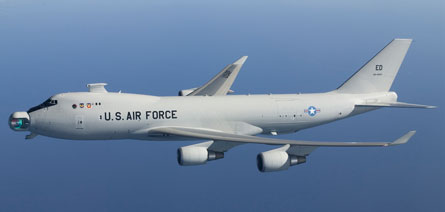Stretched freighter offers longer range, more room and new technologies, as preparations continue for 2008 test
Boeing has begun company-funded studies into using the new 747-8F freighter, instead of the 747-400F, as the platform for the US Air Force’s Airborne Laser (ABL) missile defence system. Although a decision on whether to produce further ABL systems will not be taken until after a shoot-down test planned for 2008, the only new-build platform available by then will be the new 747-8.
The YAL-1 ABL prototype – dubbed “Tail 1” – is a heavily modified 747-400 freighter, and the stretched -8 offers several potential advantages, says Greg Hyslop, vice-president and ABL programme director. “The 747-8 has longer range and more room, plus new technologies that could make it easier to integrate the mission system,” he says.
|
|---|
The Airborne Laser prototype uses a heavily modified 747-400 freighter |
Lacking funding from the US Missile Defense Agency, Boeing is spending company money on design of a production ABL.
“There is no formal decision on a second aircraft, but we are looking at various configurations,” says Hyslop. “We are investing our own funds to find synergy between the next ABL and the 747-8, to make it easier to integrate,” he says.
As the six-module high-energy chemical laser in the 747-400 already provides lethal power, Boeing is looking at the extra space inside the -8 for carrying more laser fuel and to make the system more maintainable, Hyslop says. Boeing is aiming for a more producible laser system and a quicker aircraft modification for Tail 2, he adds.
Among design changes being considered are refinement of the nose-mounted turret to provide more robust beam control and allow the ABL to operate at a higher speed. The airspeed at which the prototype can fire its laser is limited by the need to keep the shockwave behind the nose to avoid aero-optical effects on the beam, according to Hyslop.
Boeing is completing ground tests of the ABL using a low-power surrogate laser. These will be followed later this year by flight tests to measure tracking, illumination and atmospheric-compensation performance against a Boeing KC-135 modified to simulate a ballistic-missile target.
The high-energy laser will be re-installed next year for tests leading up to the shoot-down demonstration in 2008.
Source: Flight International

















